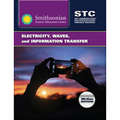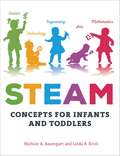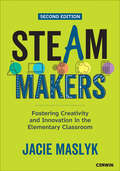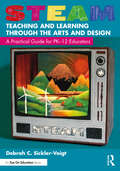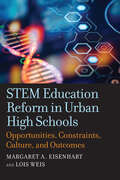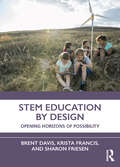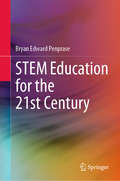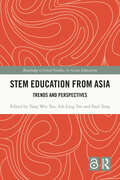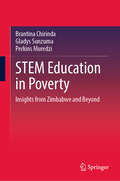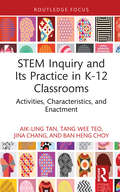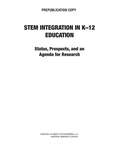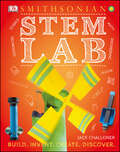- Table View
- List View
SRv6 Network Programming: Ushering in a New Era of IP Networks (Data Communication Series)
by Cheng Li Zhenbin Li Zhibo HuSRv6 Network Programming, beginning with the challenges for Internet Protocol version 6 (IPv6) network development, describes the background, roadmap design, and implementation of Segment Routing over IPv6 (SRv6), as well as the application of this technology in traditional and emerging services. The book begins with the development of IP technologies by focusing on the problems encountered during MPLS and IPv6 network development, giving readers insights into the problems tackled by SRv6 and the value of SRv6. It then goes on to explain SRv6 fundamentals, including SRv6 packet header design, the packet forwarding process, protocol extensions such as Interior Gateway Protocol (IGP), Border Gateway Protocol (BGP), and Path Computation Element Protocol (PCEP) extensions, and how SRv6 supports existing traffic engineering (TE), virtual private networks (VPN), and reliability requirements. Next, SRv6 network deployment is introduced, covering the evolution paths from existing networks to SRv6 networks, SRv6 network deployment processes, involved O&M technologies, and emerging 5G and cloud services supported by SRv6. Bit Index Explicit Replication IPv6 encapsulation (BIERv6), an SRv6 multicast technology, is then introduced as an important supplement to SRv6 unicast technology. The book concludes with a summary of the current status of the SRv6 industry and provides an outlook for new SRv6-based technologies. SRv6 Network Programming: Ushering in a New Era of IP Networks collects the research results of Huawei SRv6 experts and reflects the latest development direction of SRv6. With rich, clear, practical, and easy-to-understand content, the volume is intended for network planning engineers, technical support engineers and network administrators who need a grasp of the most cutting-edge IP network technology. It is also intended for communications network researchers in scientific research institutions and universities. Authors: Zhenbin Li is the Chief Protocol Expert of Huawei and member of the IETF IAB, responsible for IP protocol research and standards promotion at Huawei. Zhibo Hu is a Senior Huawei Expert in SR and IGP, responsible for SR and IGP planning and innovation. Cheng Li is a Huawei Senior Pre-research Engineer and IP standards representative, responsible for Huawei's SRv6 research and standardization.
SSA-based Compiler Design
by Fabrice Rastello Florent Bouchez TichadouThis book provides readers with a single-source reference to static-single assignment(SSA)-based compiler design. It is the first (and up to now only) book that coversin a deep and comprehensive way how an optimizing compiler can be designed usingthe SSA form. After introducing vanilla SSA and its main properties, the authorsdescribe several compiler analyses and optimizations under this form. They illustratehow compiler design can be made simpler and more efficient, thanks to the SSA form.This book also serves as a valuable text/reference for lecturers, making the teaching ofcompilers simpler and more effective. Coverage also includes advanced topics, such ascode generation, aliasing, predication and more, making this book a valuable referencefor advanced students and practicing engineers.
STC My Generation, Student Edition: Electricity, Waves, and Information Transfer
by The Smithsonian InstitutionThis student textbook contains lessons on Electricity, Waves, and Information Transfer.
STEAM Concepts for Infants and Toddlers
by Linda R. Kroll Nichole A. BaumgartThis book is about using Science, Technology, Engineering, the Arts, and Mathematics with very young children. STEAM is an extension of the original STEM efforts to develop scientific and mathematical thinking for use in technology and engineering with the addition of the arts and the goal to support the native creativity and innovation that all children possess. This book is organized into three sections. The first section introduces the book and discusses infant and toddler learning and development in relationship to STEAM concepts. The second section (chapters 2-6) is a series of examples of STEAM curricula in infant and toddler classrooms. The final section (chapters 7-9) focuses on classroom environments and setting up a context for effective development of STEAM curricula for teachers and effective STEAM concept learning for infants and toddlers.
STEAM Education: Theory and Practice
by Myint Swe Khine Shaljan AreepattamannilThis book looks at the value of integrating the arts and sciences in the school curriculum. It argues that this will help students further their understanding of analytical concepts through the use of creativity. The authors illustrate how schools can work towards presenting common practices, concepts, and content. Coverage features case studies and lessons learned from classrooms across the United States.The notion of STEAM (Science, Technology, Engineering, Arts, and Mathematics) is an emerging discipline unique in its desire to provide a well-rounded approach to education. The chapters of this volume examine STEAM in a variety of settings, from kindergarten to higher education. Readers will learn about the practical considerations involved when introducing the arts and creativity into traditionally left brain processes. This includes best practices for creating and sustaining successful STEAM initiatives in any school, college, or university. For instance, one chapter discusses novel approaches to teach writing with the scientific method in order to help students better present their ideas. The authors also detail how the arts can engage more diverse learners, including students who are not traditionally interested in STEM subjects. They provide three concrete examples of classroom-tested inquiries: designing a prosthetic arm for a child, making a paleontology investigation, and taking a closer look at the arts within roller coaster engineering. This book is an invaluable resource for teachers and teacher trainers, university faculty, researchers, and school administrators. It will also be of interest to science, mathematics, engineering, computer science, information technology, arts and design and technology teachers.
STEAM Makers: Fostering Creativity and Innovation in the Elementary Classroom
by Jacie MaslykEmpower creativity, collaboration, and critical thinking in your classroom! As STEAM and Making become essential components of fostering student readiness for career, college, and beyond, this new edition of STEAM Makers offers innovative ways to integrate creativity, technology, and hands-on problem-solving into daily practice. With a renewed focus on emerging technologies, environmental sustainability, and a global perspective, STEAM Makers provides educators with fresh approaches to cultivating students’ curiosity, innovation, and discovery skills. Readers will gain actionable strategies, from designing student-centered makerspaces to connecting with local and global partners, and learn from inspiring success stories from classrooms worldwide. This updated resource includes: Case studies, vignettes, and photographs of projects Practical and ready-to-use activities and STEAM Maker Starters Integration of emerging technologies like virtual reality, augmented reality, and artificial intelligence to foster 21st-century skills An expanded focus on ensuring equitable and inclusive opportunities for all With STEAM Makers, educators will gain the tools to inspire meaningful learning experiences that drive curiosity, creativity, and engagement. By fostering a mindset of exploration and design, educators can empower their students to thrive in the classroom and beyond.
STEAM Makers: Fostering Creativity and Innovation in the Elementary Classroom
by Jacie MaslykEmpower creativity, collaboration, and critical thinking in your classroom! As STEAM and Making become essential components of fostering student readiness for career, college, and beyond, this new edition of STEAM Makers offers innovative ways to integrate creativity, technology, and hands-on problem-solving into daily practice. With a renewed focus on emerging technologies, environmental sustainability, and a global perspective, STEAM Makers provides educators with fresh approaches to cultivating students’ curiosity, innovation, and discovery skills. Readers will gain actionable strategies, from designing student-centered makerspaces to connecting with local and global partners, and learn from inspiring success stories from classrooms worldwide. This updated resource includes: Case studies, vignettes, and photographs of projects Practical and ready-to-use activities and STEAM Maker Starters Integration of emerging technologies like virtual reality, augmented reality, and artificial intelligence to foster 21st-century skills An expanded focus on ensuring equitable and inclusive opportunities for all With STEAM Makers, educators will gain the tools to inspire meaningful learning experiences that drive curiosity, creativity, and engagement. By fostering a mindset of exploration and design, educators can empower their students to thrive in the classroom and beyond.
STEAM Teaching and Learning Through the Arts and Design: A Practical Guide for PK–12 Educators
by Debrah C. Sickler-VoigtIn this book, award-winning art educator Debrah C. Sickler-Voigt offers user-friendly, approachable strategies for STEAM planning, instruction, and assessment to help cultivate PK-12 students’ full potential, and draws from wide-ranging artists and designers to help you develop inspired, creative approaches to teaching STEAM in your classroom. Beginning with the basics and best practices of STEAM planning, instruction, and assessment, Sickler-Voigt then encourages readers to move full steam ahead with chapters based around diverse contemporary and historical artists and designers. In helping you to explore the interdisciplinary connections between Science, Technology, Engineering, Arts, and Mathematics, Sickler-Voigt identifies strategies to build off from STEM subjects to form authentic, well-designed, and age-appropriate learning tasks that encourage your students to make deep connections and learn subject matter in context through art media and technologies. Each chapter includes flexible, choice-based classroom resources—with tips for adapting to different grade levels—and STEAM amplifiers, which fuse contextual learning on artists and designers with real-world STEAM topics to spark student learning and ignite creative approaches to planning, instruction, and assessment. Featuring 150 visually stunning, full-color images, this book fuses tried-and-true best practices with highly applicable instructional models inspired by artists and STEAM professionals, ideal for PK-12 teachers and STEAM specialists.
STEM Education Reform in Urban High Schools: Opportunities, Constraints, Culture, and Outcomes
by Lois Weis Margaret A. EisenhartSTEM Education Reform in Urban High Schools gives a nuanced view of the obstacles marginalized students face in STEM education—and explores how schools can better support STEM learners.Reporting the results of a nine-year ethnographic study, the book chronicles the outcomes of various STEM education reforms in eight public high schools with nonselective admissions policies and high proportions of low-income and minoritized students: four schools in Denver, Colorado, and four in Buffalo, New York.Margaret A. Eisenhart and Lois Weis follow the educational experiences of high-ability students from each school, tracking the students' high school-to-college-to-career trajectories. Through interviews with students, educators, and parents, as well as classroom and campus observations, the authors identify patterns in the educational paths of students who go on to great success in STEM occupations and those who do not. They discuss common mechanisms that undermine the stated goals of STEM programming—opportunity structures that are inequitable, erosion of program quality, and diversion of resources—as well as social and cultural constructs (the figured worlds of STEM) that exclude many minoritized students with potential for success from the STEM pipeline.On a broader scope, the book explores how and why STEM education reform efforts fail and succeed. With an eye toward greater access to STEM learning, the authors show how lessons of past measures can inform future STEM initiatives.
STEM Education by Design: Opening Horizons of Possibility
by Sharon Friesen Brent Davis Krista FrancisAn accessible text that assumes no prior knowledge, this book is grounded in the realization that "STEM" and "STEM Education" have not yet evolved into fully coherent fields of study, and fills this gap by offering an original model and strategy for developing coherences in a way that both honors the integrity of each of STEM’s constituent disciplines and explores the ways they can amplify one another when used together to address complex contemporary issues. This book demonstrates how STEM can and should be understood as more than a collection of disciplines; it is a transdisciplinary, possibility-rich domain that is much more than the sum of its parts. Building on the actual work of scientists, engineers, and other professionals, the authors disrupt preconceptions about STEM domains, and provide the tools and evidence-based approaches to create new possibilities for all learners. Covering historical influences, theoretical frameworks, and current debates and challenges, this book positions teachers and students as agents of change. Each chapter features In Brief openers to introduce the topic; Opening Anecdotes to reflect the chapter’s key themes; Sidebars to put core principles in context; Consolidating Key Points activities to summarize and highlight important details; and Challenges to build upon and extend topics explored in the chapter from different angles.
STEM Education by Design: Opening Horizons of Possibility
by Sharon Friesen Brent Davis Krista FrancisAn accessible text that assumes no prior knowledge, this book is grounded in the realization that "STEM" and "STEM Education" have not yet evolved into fully coherent fields of study, and fills this gap by offering an original model and strategy for developing coherences in a way that both honors the integrity of each of STEM’s constituent disciplines and explores the ways they can amplify one another when used together to address complex contemporary issues. This book demonstrates how STEM can and should be understood as more than a collection of disciplines; it is a transdisciplinary, possibility-rich domain that is much more than the sum of its parts. Building on the actual work of scientists, engineers, and other professionals, the authors disrupt preconceptions about STEM domains, and provide the tools and evidence-based approaches to create new possibilities for all learners. Covering historical influences, theoretical frameworks, and current debates and challenges, this book positions teachers and students as agents of change. Each chapter features In Brief openers to introduce the topic; Opening Anecdotes to reflect the chapter’s key themes; Sidebars to put core principles in context; Consolidating Key Points activities to summarize and highlight important details; and Challenges to build upon and extend topics explored in the chapter from different angles.
STEM Education for High-Ability Learners
by Bronwyn MacfarlaneSTEM Education for High-Ability Learners: Designing and Implementing Programming focuses on the rigorous articulation of quality STEM education programming to develop STEM talent among high-ability and gifted learners. The intent of this book is to provide a comprehensive resource for educators designing and implementing each of the supports within STEM education by providing a discussion of each critical component for inclusion in a planned, coherent, and high-quality sequenced system. This edited volume provides a cutting-edge discussion of best practices for delivering STEM education by experts in the field. The contributing authors provide a differentiated discussion and recommendations for the learning experiences of gifted students in STEM education programs.
STEM Education for the 21st Century (Springerbriefs In Education Ser.)
by Bryan Edward PenpraseThis book chronicles the revolution in STEM teaching and learning that has arisen from a convergence of educational research, emerging technologies, and innovative ways of structuring both the physical space and classroom activities in STEM higher education. Beginning with a historical overview of US higher education and an overview of diversity in STEM in the US, the book sets a context in which our present-day innovation in science and technology urgently needs to provide more diversity and inclusion within STEM fields. Research-validated pedagogies using active learning and new types of research-based curriculum is transforming how physics, biology and other fields are taught in leading universities, and the book gives profiles of leading innovators in science education and examples of exciting new research-based courses taking root in US institutions. The book includes interviews with leading scientists and educators, case studies of new courses and new institutions, and descriptions of site visits where new trends in 21st STEM education are being developed. The book also takes the reader into innovative learning environments in engineering where students are empowered by emerging technologies to develop new creative capacity in their STEM education, through new centers for design thinking and liberal arts-based engineering. Equally innovative are new conceptual frameworks for course design and learning, and the book explores the concepts of Scientific Teaching, Backward Course Design, Threshold Concepts and Learning Taxonomies in a systematic way with examples from diverse scientific fields. Finally, the book takes the reader inside the leading centers for online education, including Udacity, Coursera and EdX, interviews the leaders and founders of MOOC technology, and gives a sense of how online education is evolving and what this means for STEM education. This book provides a broad and deep exploration into the historical context of science education and into some of the cutting-edge innovations that are reshaping how leading universities teach science and engineering. The emergence of exponentially advancing technologies such as synthetic biology, artificial intelligence and materials sciences has been described as the Fourth Industrial Revolution, and the book explores how these technologies will shape our future will bring a transformation of STEM curriculum that can help students solve many the most urgent problems facing our world and society.
STEM Education from Asia: Trends and Perspectives (Routledge Critical Studies in Asian Education)
by Aik-Ling Tan Tang Wee Teo Paul TengAsia is the largest continent in the world. Five out of the top ten high performing economies in the Programme for International Student Assessment (PISA) 2018 are located in Asia. Why do Asian students perform so well in STEM-related subjects? This book answers this by examining the STEM education policies and initiatives in Asian economies, as well as the training programmes undertaken by STEM teachers in Asia. The book is broken into four sections, each accompanied by a passage of commentary that summarizes the key takeaways of the chapters. Section one focuses on STEM policy environments and how various countries have developed policies that promote STEM as an integral part of national economic development. Section two focuses on STEM teacher education in the Philippines and Thailand, while section three focuses on STEM curriculum design, context, and challenges in four Asian economies. The fourth and final section focuses on presenting snapshots of STEM education research efforts in Malaysia, South Korea, and Singapore. Written by Asian academics, this book will provide valuable insights to policy makers, educators, and researchers interested in the topic of STEM education, especially in the Asian context.
STEM Education in Poverty: Insights from Zimbabwe and Beyond
by Brantina Chirinda Gladys Sunzuma Perkins MuredziThis book is about Science, Technology, Engineering, and Mathematics (STEM) education in poverty and the lessons we learn from Zimbabwe. The world is driving towards the fourth Industrial Revolution (4IR), where economic growth has been attributed to STEM education. STEM education is vital in this era, where both developed and developing countries are undergo rapid changes. Globally, STEM education has been practised differently in schools and universities. University programs, new school curricula, instructional methods, extracurricular programs, and professional development programs for in-service teachers have been created to cater to STEM subjects. STEM education is envisioned to produce critical thinkers, inventors, creators, problem solvers, innovators, and professionals who will solve the world’s ever-changing challenges, including inequity, food insecurity, climate change, inequality, and poverty. STEM is essential to modern education. Zimbabwe has faced significant economic challenges but has made remarkable strides in STEM education. By examining the successes and challenges of STEM education in Zimbabwe, we can learn valuable lessons about improving STEM education in underserved communities. This book contributes to the international debate surrounding the optimal STEM education for students in underserved schools. It incorporates detailed accounts of STEM education in Zimbabwe schools, shedding light on the challenges students and educators face in impoverished areas. In Zimbabwe, STEM education faces significant challenges such as materials and facilities, pedagogy, policy reform, access, and relevance. Some of the main issues highlighted in this book are the need for more resources, including funding, teaching materials, and adequate laboratories. Effective STEM pedagogy is hampered by an education system that emphasises the curriculum and teacher-centred focus instead of focusing on how students can be taught or learn. Research has shown that in Zimbabwe, STEM teachers must apply inventive pedagogies and suitable learner-centred STEM teaching approaches. As a result, there is a need for more STEM-related programs and courses in schools and universities to improve the opportunities for students to pursue careers in these fields. Another challenge is the need for more awareness about the opportunities and importance of STEM education and interest in STEM subjects among students, which can be attributed to a lack of exposure and understanding of the relevance and importance of these fields in today's world. While lack of resources and other challenges hinder effectiveness, opportunity lies in promising pathways of policy and practice. In Zimbabwe, there is a varying degree of success in the implemented competence-based curriculum, which emphasises inquiry-based learning and STEM education. Finally, there is a need for early exposure to STEM-based career opportunities and for more collaboration between the government, private sector, and educational institutions to address these challenges and promote STEM education in Zimbabwe. This book uses Zimbabwe as an example to explore STEM education in poverty. By examining the successes and challenges of STEM education in Zimbabwe, this book offers valuable insights into how STEM education can be integrated into the curriculum in countries with developing and emerging economies. This book is an essential resource for anyone interested in improving STEM education in underserved communities.
STEM Education with Robotics: Lessons from Research and Practice
by Vikram Kapila Purvee ChauhanThis book offers a synthesis of research, curriculum examples, pedagogy models, and classroom recommendations for the effective use of robotics in STEM teaching and learning. Authors Chauhan and Kapila demonstrate how the use of educational robotics can catalyze and enhance student learning and understanding within the STEM disciplines. The book explores the implementation of design-based research (DBR); technological, pedagogical, and content knowledge (TPACK); and the 5E instructional model; among others. Chapters draw on a variety of pedagogical scaffolds to help teachers deploy educational robotics for classroom use, including research-driven case studies, strategies, and standards-aligned lesson plans from real-life settings. This book will benefit STEM teachers, STEM teacher educators, and STEM education researchers.
STEM Inquiry and Its Practice in K-12 Classrooms: Activities, Characteristics, and Enactment (Routledge Research in STEM Education)
by Aik-Ling Tan Tang Wee Teo Jina Chang Ban Heng ChoyThrough examining the theoretical ideas of disciplinarity and disciplinary practices, the book presents instructional aspects for teachers to explore when engaged with integrated STEM inquiry.Are you interested to understand the difference between science inquiry and STEM inquiry? Do you want to introduce integrated STEM problem solving to your students but need help with the key features of STEM inquiry? This book presents in-depth discussions related to the features and affordances of integrated STEM inquiry. Written for K-12 teachers and teacher educators, this book conceptualises STEM inquiry and integrated STEM and their enactment, using three practical STEM instructional frameworks: problem-centric, solution/design-centric, and user-centric STEM. The three STEM instructional frameworks serve as a key anchor for teachers to interpret and apply when planning various STEM lessons in meaningful, practical, and coherent ways.Whether you are an aspiring K-12 STEM teacher or an in-service teacher teaching K-12 students, the ideas of integrated STEM inquiry presented in this book challenge educators to think about the principles of integrated STEM inquiry and how they can be incorporated into classroom practice and lessons.
STEM Integration in K-12 Education
by Margaret Honey"STEM Integration in K-12 Education" examines current efforts to connect the STEM disciplines in K-12 education. This report identifies and characterizes existing approaches to integrated STEM education, both in formal and after- and out-of-school settings. The report reviews the evidence for the impact of integrated approaches on various student outcomes, and it proposes a set of priority research questions to advance the understanding of integrated STEM education. "STEM Integration in K-12 Education" proposes a framework to provide a common perspective and vocabulary for researchers, practitioners, and others to identify, discuss, and investigate specific integrated STEM initiatives within the K-12 education system of the United States. "STEM Integration in K-12 Education" makes recommendations for designers of integrated STEM experiences, assessment developers, and researchers to design and document effective integrated STEM education. This report will help to further their work and improve the chances that some forms of integrated STEM education will make a positive difference in student learning and interest and other valued outcomes.
STEM Lab (DK Activity Lab)
by Jack ChallonerFrom racing wind up cars to making music with a homemade guitar, STEM Lab will excite and inspire curious young minds.STEM Lab is packed with 25 exciting STEM activities, perfect for firing up kids&’ imaginations. Explore and discover beautifully illustrated science activities with an easy to follow guide that will explain how science, technology, engineering and math shape the world around us. A perfect balance between education and fun, STEM Lab teaches young readers through each experiment, describing the science behind it and providing engaging STEM facts. The richly illustrated activities promote further thinking by suggested &“Test and Tweak&” notes. Encourage young readers to take their projects to the next level, while furthering their understanding of the science behind it. Each activity has its own &‘How It Works&” section covering STEM principles to help young minds understand answers to their science curiosity, exercising cognitive thinking and problem-solving skills.Learn The Science Behind 25 Amazing ProjectsScience activities for kids that can be done at home. Leap into the exciting world of STEM where Science, Technology, Engineering and Math combine in 25 fun and easy-to-do projects. STEM Lab teaches young readers how to make impressive insulating gloves, stunning spaghetti towers, amazing automations, and explores many more educational activities.STEM subjects are a crucial part of a child&’s education. STEM Lab helps kids to practice STEM principles in a fun and engaging manner, while exercising motor skills and cognitive thinking. The four subject areas this book is based on are interrelated, and by combining them new insights, ideas and solutions to problems emerge. STEM Lab will teach you the principles of engineering and the science behind it.This STEM filled activity book is organised into four sections:- Forces and Motion- Liquids and Reactions- Shapes and Structures - Light and SoundSTEM Lab combines fun and learning with hand-on activities that engages STEM principles.
STEM Learning
by Mesut Duran Margret Höft Brahim Medjahed Daniel B. Lawson Elsayed A. OradyThis book reports the results of a three-year research program funded by the National Science Foundation which targeted students and teachers from four Detroit high schools in order for them to learn, experience, and use IT within the context of STEM (IT/STEM), and explore 21st century career and educational pathways. The book discusses the accomplishment of these goals through the creation of a Community of Designers-- an environment in which high school students and teachers, undergraduate/graduate student assistants, and STEM area faculty and industry experts worked together as a cohesive team. The program created four project-based design teams, one for each STEM area. Each team had access to two year-round IT/STEM enrichment experiences to create high-quality learning projects, strategies, and curriculum models. These strategies were applied in after school, weekend, and summer settings through hands-on, inquiry-based activities with a strong emphasis on non-traditional approaches to learning and understanding. The book represents the first comprehensive description and analysis of the research program and suggests a plan for future development and refinement.
STEM Learning Is Everywhere: Summary of a Convocation on Building Learning Systems
by Steve OlsonScience, technology, engineering, and mathematics (STEM) permeate the modern world. The jobs people do, the foods they eat, the vehicles in which they travel, the information they receive, the medicines they take, and many other facets of modern life are constantly changing as STEM knowledge steadily accumulates. Yet STEM education in the United States, despite the importance of these subjects, is consistently falling short. Many students are not graduating from high school with the knowledge and capacities they will need to pursue STEM careers or understand STEM-related issues in the workforce or in their roles as citizens. For decades, efforts to improve STEM education have focused largely on the formal education system. Learning standards for STEM subjects have been developed, teachers have participated in STEM-related professional development, and assessments of various kinds have sought to measure STEM learning. But students do not learn about STEM subjects just in school. Much STEM learning occurs out of school--in organized activities such as afterschool and summer programs, in institutions such as museums and zoos, from the things students watch or read on television and online, and during interactions with peers, parents, mentors, and role models. To explore how connections among the formal education system, afterschool programs, and the informal education sector could improve STEM learning, a committee of experts from these communities and under the auspices of the Teacher Advisory Council of the National Research Council, in association with the California Teacher Advisory Council organized a convocation that was held in February 2014. Entitled "STEM Learning Is Everywhere: Engaging Schools and Empowering Teachers to Integrate Formal, Informal, and Afterschool Education to Enhance Teaching and Learning in Grades K-8," the convocation brought together more than 100 representatives of all three sectors, along with researchers, policy makers, advocates, and others, to explore a topic that could have far-reaching implications for how students learn about STEM subjects and how educational activities are organized and interact. This report is the summary of that meeting. "STEM Learning is Everywhere" explores how engaging representatives from the formal, afterschool, and informal education sectors in California and from across the United States could foster more seamless learning of STEM subjects for students in the elementary and middle grades. The report also discusses opportunities for STEM that may result from the new expectations of the Next Generation Science Standards and the Common Core Standards for Mathematics and Language Arts.
STEM Learning in Extended Reality: Research, Design, and Examples (Synthesis Lectures on Engineering, Science, and Technology)
by Ferdinand RiveraThis book synthesizes findings from recent and ongoing research on the use of Extended Reality (XR) to support learning of STEM content. XR is slowly being introduced in classrooms due to significant changes in XR technology. These tools were historically costly, unfriendly, and developed only for gamers. Today, XR tools are able to enhance students’ immersive experiences in such settings. In classrooms, in particular, they provide learners with an opportunity to manipulate abstract objects as if they are physical objects. The book begins with an extensive and detailed description and evaluation of the impact of various XR interventions on learning and engagement in STEM classrooms. The author then concludes with theoretical frameworks for investigating learning in computer- immersive contexts and practical implications for effectively using XR tools to learn STEM.
STEM Literacies in Makerspaces: Implications for Learning, Teaching, and Research
by Eli Tucker-Raymond Brian E. GravelProviding an original framework for the study of makerspaces in a literacy context, this book bridges the scholarship of literacy studies and STEM and offers a window into the practices that makers learn and interact with. Tucker-Raymond and Gravel define and illustrate five key STEM literacies—identifying, organizing, and integrating information; creating and traversing representations; communicating with others for help and feedback during making; documenting processes; and communicating finished products—and demonstrate how these literacies intersect with making communities. Through careful observation and analysis of multiple case studies, the authors highlight the impact of research and practice to support teaching and making in a variety of environments. Using a nuanced, engaging framework, they examine the necessary skills required to develop and foster makerspaces in formal and informal contexts for all students. Grounded in cutting-edge research, this volume paves the way for future study on supporting making and literacies in STEM.
STEM Road Map 2.0: A Framework for Integrated STEM Education in the Innovation Age
by Carla C. Johnson, Erin E. Peters-Burton, and Tamara J. MooreFeaturing a team of over thirty STEM education professionals from across the United States, the updated and revised edition of this landmark book provides an integrated STEM curriculum encompassing the entire K-12 spectrum, with complete grade-level learning based on a spiraled approach to building conceptual understanding. Taking into account the last five years of evolution in STEM education, the second edition includes an increased focus on computer science, computational thinking, mathematics, and the arts, as well as cultural relevance and addressing the needs of diverse learners and underrepresented students. Divided into three main parts – Conceptualizing STEM, STEM Curriculum Maps, and Building Capacity for STEM – each section is designed to build common understandings of integrated STEM, provide rich curriculum maps for implementing integrated STEM at the classroom level, and offer supports to enable systemic transformation to an integrated STEM approach. Written for teachers, policymakers, and administrators, this second edition is fully updated to account for the needs of K-12 learners in the innovation age. STEM Road Map 2.0 enables educators to implement integrated STEM learning into their classroom without the need for extensive resources, empowering educators and supporting students.
STEM Road Map: A Framework for Integrated STEM Education
by Carla C. Johnson Erin E. Peters-Burton Tamara J. MooreSTEM Road Map: A Framework for Integrated STEM Education is the first resource to offer an integrated STEM curricula encompassing the entire K-12 spectrum, with complete grade-level learning based on a spiraled approach to building conceptual understanding. A team of over thirty STEM education professionals from across the U.S. collaborated on the important work of mapping out the Common Core standards in mathematics and English/language arts, the Next Generation Science Standards performance expectations, and the Framework for 21st Century Learning into a coordinated, integrated, STEM education curriculum map. The book is structured in three main parts—Conceptualizing STEM, STEM Curriculum Maps, and Building Capacity for STEM—designed to build common understandings of integrated STEM, provide rich curriculum maps for implementing integrated STEM at the classroom level, and supports to enable systemic transformation to an integrated STEM approach. The STEM Road Map places the power into educators’ hands to implement integrated STEM learning within their classrooms without the need for extensive resources, making it a reality for all students.


